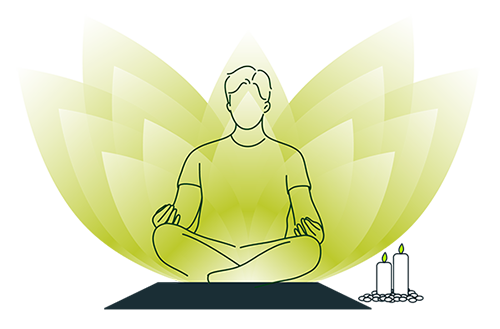Mindful food relies on mindfulness, which is a form of meditation. Mindful eating is
about developing awareness of our experiences, physical cues, and feelings about food.
Actually, it’s been derived from a Buddhist concept.
Mindful living starts with mindful eating. Mindful eating is developing an
awareness of what we eat, how we eat, where our food comes from, and what it does to us,
and our entire eco-system. Food is directly connected to our mental and physical health.
Our body is just an accumulation of the food we eat after it has been
transformed and assimilated. There is a certain intelligence, memory, and genetic code
in the body that determines what the food that we eat is converted into. For example,
the same apple, depending on who eats it, becomes part of the body of a woman, a man, or
a cow. Similarly, there is information about the food we consume. The way our food is
harvested, how far it has traveled, and how we are feeling while consuming the food, all
these aspects determine our mental and physical wellbeing.
One very important aspect of mindful food is how we are feeling when we are
about to consume food. We should spend a few moments to be thankful for the food that is
about to nourish us. It is of utmost significance that we generate feelings of gratitude
towards all the lives that contributed to bringing the food to our plate, including the
life of the food itself. This not only changes how our body handles the food but how the
food handles our body.
Another aspect of food is that it is essentially the fuel to the body and also
the mind. If we want to refuel our car, we go to the station and choose the appropriate
fuel for this particular machine, to achieve optimal performance. We could put kerosene
into our car, and it would drive, but it may smoke and cough, and we may not be able to
accelerate as we want. This is the situation with most of us when it comes to our food
choices. To choose the appropriate fuel, we need to know what type of machine we are.
The ideal fuel for your body is what leaves you alert, agile, and active.
However, eating properly is an important aspect of health. If we are interested
in our wellbeing and that of our children, we must ensure that the food you eat is
fresh. In the yogic culture, cooked food is consumed within 1.5 hours after it comes off
the stove. If it’s any later, inertia will set in. If we eat food that creates inertia
in the system, we will lose all our dynamism. There is also a correlation between the
kind of food we eat and the amount of sleep you need. Generally, doctors advise that
everyone must sleep a minimum of eight hours. If we sleep eight hours per night, it
means we are sleeping one-third of our life. The body needs restfulness, not sleep. One
important factor of how much sleep we need is what type of fuel we put into your system.
If we put the wrong fuel into our car, it will need a lot of services. Similarly, if we
put the wrong fuel (food) into our system, it will need a lot of sleep.
In the yogic tradition, we always said you must eat what is furthest away from
you, genetically. In that sense, plant life is furthest away from us. If you must eat
non-vegetarian food, we advise the consumption of fish, because, among the animals, it
is furthest away from a human being, if you look at it from an evolutionary perspective.
As the first animal life on the planet is thought to have evolved in water, indicating
the fish.
After a century of saying, the best thing to eat is meat, doctors in the West
are slowly shifting to a different view today. For some time now, they have been saying
that beef is the main cause for most of the cardiac ailments and cause of cancer in
America. In the yogic culture, it is said that if you eat foods with a complex genetic
code, your system will break down, one way or the other. So, do not make food some kind
of religion. If it is a question of survival, eat – what is available. But when survival
is taken care of, there is a choice. When you have a choice, you must eat sensibly,
which is best for your system.
Tips:
– Try paying close attention to the taste of the food you are eating. Eat slowly,
carefully, and silently. Chew your food thoroughly. Try to notice every ingredient
within each mouthful of food. Mindfulness will help you to experience the true joy of
eating and will likewise draw your attention to the silent power contained within every
moment.
– You could experiment by yourself. One day, just eat fruits; another day, just
eat raw vegetables; yet another day, you cook the vegetables; then you eat fish, you eat
meat – try out everything. Pay attention to how your body feels. It will differ from one
person to another as our genes and other aspects of life also differ. With whichever
kind of food, we experience maximum levels of energy and alertness in our body that is
what we should eat to be healthy.
– Having organic food regularly delivers a 3-way of health benefits such as –
rich nutrients, naturally harvested and restoring mindset. Also, mindful eating may
effectively treat common, unhealthy eating behaviors like emotional and external eating.
– To transition from mindless to mindful eating, try some of the simple tips
above. In doing so, we may improve our overall health and even lose weight in a way that
feels easy and can be maintained over the long term.









